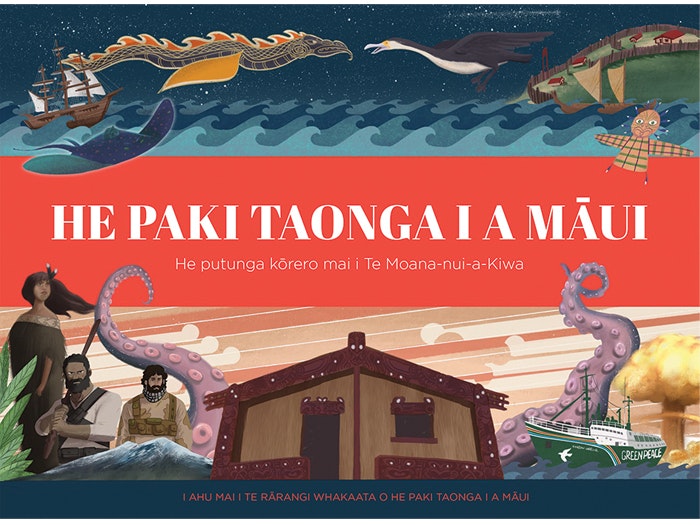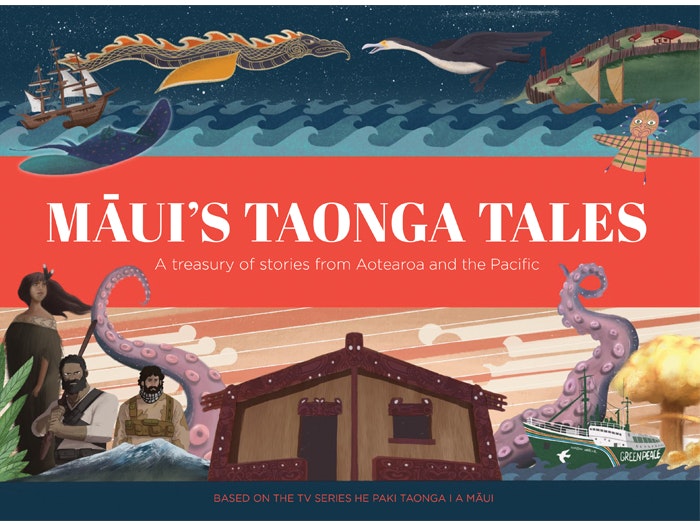
He Paki Taonga i a Māui: He Putanga Kōrero Mai i Te Moana-Nui-a-Kiwa
Join Māui as he shares stories for tamariki based on taonga from the Te Papa collection
Free museum entry for New Zealanders and people living in New Zealand
Open every day 10am-6pm
(except Christmas Day)
Free museum entry for New Zealanders and people living in New Zealand
David Brechin-Smith and Ranea Aperahama discuss He Paki Taonga i a Māui with Te Papa Press
He Paki Taonga i a Māui, and the English edition, Māui's Taonga Tales, evolved out of a television series made by well-known television production company Production Shed. The stories have been developed by former Te Papa Senior Writer and He Paki Taonga i a Māui co-producer, David Brechin-Smith, and Te Papa Te Reo Writer, Ranea Aperahama.
David Brechin-Smith: The idea for the series came while I was working on the Rongowhakaata iwi exhibition at Te Papa. Zak Waipara created an animation for the exhibition about the 1769 Cook encounter in Tūranganui-a-Kiwa. The story was told from perspective of iwi, which is very different to European accounts (if you read only one story in the book, make it that one). It made me think about our ‘untold history’ and how best to reveal it. That’s where it all started.
Ranea Aperahama: David seeded the concept for the series inspired by the many Te Papa exhibitions that we were blessed to write about together. A love and understanding grew in Mana Taonga. The exhibition Te Taiao | Nature and its principles, Te Maihi Karauna, the government Māori language strategy to ensure te reo Māori is seen, heard, spoken, and generating revenue for Te Papa all influenced the development of He Paki Taonga i a Māui. The flow on into TV and publishing was a natural progression.
DB-S: It was always about the story – it needed drama, great characters, and a positive theme even when the subject matter was in some way negative (like the New Zealand Wars or the Rainbow Warrior bombing). Some taonga already had a great story directly connected to them, such as ‘Ruhia’s lifesaving cloak’. With other stories, we found taonga that gave us a way into the story: we used a beautiful kahu huruhuru for ‘Battle of the Birds’, and a tōtara tauihu for ‘Rata and the Children of Tāne’.
RA: The taonga, the story itself guided the process. An inspiring story teller who connected all peoples of our nation was obvious – ko Māui Tikitiki-a-Taranga – who emotively retold humanity's valuable life lessons about love, peace, understanding and courage to care for one another and our beautiful homes of Te Moana-nui-a-Kiwa.
DB-S: I knew most of the stories, to varying degrees. Ranea brought some great stories to the table, as did Te Papa curator Matiu Baker. They’re both brimming with amazing kōrero!
RA: ‘How the Kiwi lost its Wings’. It’s a beautiful story about self-sacrifice and love for others.
DB-S: Keep the stories simple and tell them using contemporary language. I need to thank our wonderful writers Victoria Cleal, Matthew Grainger, Frances Samuel, and Jen Craddock for achieving this. They retold the stories in English, and Stephanie Tibble wrote the beautiful and very cool Māori adaptations.
RA: The timeless self-reflection messages that each story convey is retold with an understanding of context that aligns with current events, such as climate change, the wellbeing of children, Tuia 250. Our nation is maturing.
DB-S: I wasn’t actually on a language ‘advancement mission’ when I came up with the idea. I was on a ‘tell untold history and other great stories’ mission. But the series and book was always going to be 100 percent te reo Māori, because all the stories are connected to Aotearoa, almost all the taonga are taonga Māori, and Māui is our storyteller. These stories were always going to be best told in te reo Māori. And now, I’m definitely on a language advancement mission – making the series very much set me on that course.
RA: It’s for tamariki aged seven to eleven. The level of te reo Māori specifically is targeted to children immersed in Māori language education. The TV series He Paki Taonga i a Māui has been expressed and presented in a very ‘Māori – Mana Taonga’ way. It is the first of its kind!
DB-S: An important key concept for the series was to have a different illustrative style for each story. That meant we needed to work with more than one artist. So we put the call out and got a really positive response. We got over twenty Māori artists who said they’d be keen. From those, we chose eight. And what an absolutely amazing group: Munro Te Whata, Te Hana Goodyer, Izzy Joy Te Aho-White, Huriana Kopeke-Te Aho, Josh Morgan, Miriama Grace-Smith, Ariki Brightwell, and Reweti Arapere. Pretty wonderful line-up, eh? I feel incredibly privileged to have been able to work with them. I mean, just look at what they did! Beautiful.
RA: Each unique illustrator was carefully discussed with me and selected by David, based on their skills and abilities to deliver beautiful emotive illustrations, and based also on their tribal connection to each taonga, encouraging and empowering the descendants to be the ‘interpretive voice’ of their taonga.
DB-S: He’s past, present, and future. He knows all these stories because they are of this land, and Māui is of this land. These stories are him, and us – and he, and we, are them. Kahukura Royal, who plays Māui, embodied all of that, and more: Māui the trickster, the shapeshifter, the teacher, the explorer. Watch his performance in the series and you’ll know exactly what I mean. I’m deeply grateful to Ranea – he worked with Kahukura to add a wonderful depth to the storytelling that wasn’t in the scripts. Truly inspiring.
RA: Most Pacific peoples trace descent from Māui. Māui unifies the Pacific – Vikings of the Pacific, Vikings of the Stars!
DB-S: There’s not just one – I think they’re all fascinating, which is why we chose them. For example, Ruhia's cloak is really cool because you look at it and you think ‘Wow, that’s the actual cloak that was draped over Thomas McKenzie to save his life, in 1840’.
RA: All the taonga in He Paki Taonga i a Māui are powerful. But Maungaroa is very special to me. I live in Porirua, where Kupe left it. I live in Hongoeka, where I am blessed to see Te Mana-nui-o-Kupe-ki-Aotearoa (Mana Island) every day. A reminder that he was not a myth. Although Kupe is claimed by many iwi, I am a descendant of Kupe.
DB-S: That the concept works.
RA: That Te Papa stands at a high advantage point – because of Mana Taonga – to streamline Te Maihi Karauna strategy. Te Papa Press; Te Māngai Pāho (Māori language broadcasting), Te Taura Whiri i te Reo Māori (Maori Language Commission), Te Tāhuhu o te Mātauranga (Ministry of Education).
DB-S: That’s there’s way more to the history of Aotearoa than you might have known. And that the history you thought you knew is usually told from a European perspective – but that's just one side of the story. Read or watch ’The Deadly Encounter of 1769’ and you’ll know what I mean.
RA: To be inspired to heal the past mistakes of humanity upon one another and nature. To anchor te reo Māori/reo Kiwi into the hearts of the next generation of ‘our tamariki of Aotearoa’, and to encourage visitation to the Te Papa by the descendants of Māui and the Mana Taonga, and all descendants of the Treaty of Waitangi, Māori and Pākehā alike. Homai te pakipaki! He paki taonga i a Māui!

Join Māui as he shares stories for tamariki based on taonga from the Te Papa collection

Join Māui as he shares stories for tamariki based on taonga from the Te Papa collection